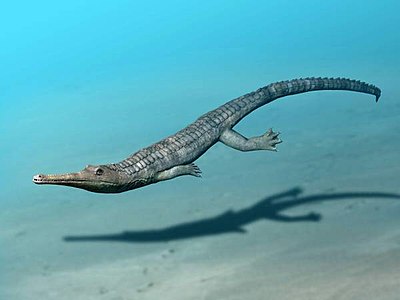Teleosauridae
The teleosaurids were marine crocodyliforms similar to the modern gharial that lived from the Early Jurassic to the Early Cretaceous. They had long snouts, indicative of piscivory (fish eating) and were the closest relatives to the Metriorhynchidae, the Mesozoic crocodilians that returned to the sea and evolved paddle-like forelimbs and a shark-like tail.
| Teleosaurids | |
|---|---|
 | |
| Life reconstruction of 'Steneosaurus' bollensis | |
| Scientific classification | |
| Kingdom: | Animalia |
| Phylum: | Chordata |
| Class: | Reptilia |
| Clade: | Neosuchia |
| Suborder: | †Thalattosuchia |
| Superfamily: | †Teleosauroidea Geoffroy, 1831 |
| Family: | †Teleosauridae Geoffroy, 1831 |
| Synonyms | |
Geographical distribution
The family has a wide geographic distribution, with material found in Africa (Ethiopia, Madagascar and Morocco), Europe (England, France, Germany, Italy, Portugal, Russia and Switzerland), North America (Oregon), South America (Argentina), India, China, and Thailand.[3][4][5][6][7][8]
Genera
| Genus | Age | Location | Description | Synonyms |
|---|---|---|---|---|
|
Formerly referred to "Teleosaurus" and "Steneosaurus" megarhinus.[9] |
||||
|
Species formerly referred to "Steneosaurus" larteti.[10] |
||||
|
Recovered as a basal member of Metriorhynchoidea in recent studies.[12] |
||||
|
Genus is nomen dubium and a wastebasket taxon; includes multiple species not referable to it. |
||||
|
Species formerly referred to "Steneosaurus" boutilieri.[10] |
||||
The dagger † indicates extinct genera.
See also
References
- Fanti, Federico; Miyashita, Tetsuto; Cantelli, Luigi; Mnasri, Fawsi; Dridi, Jihed; Contessi, Michela; Cau, Andrea (2016). "The largest thalattosuchian (Crocodylomorpha) supports teleosaurid survival across the Jurassic-Cretaceous boundary". Cretaceous Research. 61: 263–274. doi:10.1016/j.cretres.2015.11.011.
- Fitzinger LJFJ. 1843. Systema Reptilium. Wien: Braumüller et Seidel, 106 pp.
- Steel R. 1973. Crocodylia. Handbuch der Paläoherpetologie, Teil 16. Stuttgart: Gustav Fischer Verlag,116 pp.
- Bardet, N; Hua, S (1996). "Simolestes nowackianus HUENE, 1938 from the Late Jurassic of Ethiopia is a teleosaurid crocodile, not a pliosaur". Neues Jahrbuch für Geologie und Paläontologie, Monatshefte. 1996: 65–71. doi:10.1127/njgpm/1996/1996/65.
- Buffetaut, E (1979). "Jurassic marine crocodilians (Mesosuchia, Teleosauridae) from central Oregon; first record in North America". Journal of Paleontology. 53 (1): 10–215.
- Owen, R (1852). "Note on the crocodilians remains accompanying Dr. T.L. Bell's paper on Kotah". Quarterly Journal of the Geological Society of London. 8: 233.
- Delfino, M; Dal Sasso, C (2006). "Marine reptiles (Thalattosuchia) from the Early Jurassic of Lombardy (northern Italy)". Geobios. 39 (3): 346–354. doi:10.1016/j.geobios.2005.01.001. hdl:2318/79280.
- Storrs GW, Efimov MB. 2000. Mesozoic crocodyliformes of north-central Eurasia. In: Benton M, Shishkin MA, Unwin DM, Kurichkin EN (eds). The Age of Dinosauria in Russia and Mongolia. P. 402-419, Cambridge University Press, Cambridge.
- Foffa, D.; Johnson, M.M.; Young, M.T.; Steel, L.; Brusatte, S.L. (2019). "Revision of the Late Jurassic deep-water teleosauroid crocodylomorph Teleosaurus megarhinus Hulke, 1871 and evidence of pelagic adaptations in Teleosauroidea". PeerJ. 7: e6646. doi:10.7717/peerj.6646. PMC 6450380. PMID 30972249.
- Johnson, Michela M.; Young, Mark T.; Brusatte, Stephen L. (2019). "Re-description of two contemporaneous mesorostrine teleosauroids (Crocodylomorpha: Thalattosuchia) from the Bathonian of England and insights into the early evolution of Machimosaurini". Zoological Journal of the Linnean Society. in press. doi:10.1093/zoolinnean/zlz037. hdl:1842/36656.
- Martin, Jeremy E.; Suteethorn, Suravech; Lauprasert, Komsorn; Tong, Haiyan; Buffetaut, Eric; Liard, Romain; Salaviale, Celine; Deesri, Uthumporn; Suteethorn, Varavudh; Claude, Julien (2019). "A new freshwater teleosaurid from the Jurassic of northeastern Thailand" (PDF). Journal of Vertebrate Paleontology. 38 (6): e1549059. doi:10.1080/02724634.2018.1549059.
- Young, M. T.; Brusatte, S. L.; De Andrade, M. B.; Desojo, J. B.; Beatty, B. L.; Steel, L.; Fernández, M. S.; Sakamoto, M.; Ruiz-Omeñaca, J. I.; Schoch, R. R. (2012). ""The Cranial Osteology and Feeding Ecology of the Metriorhynchid Crocodylomorph Genera Dakosaurus and Plesiosuchus from the Late Jurassic of Europe". In Butler, Richard J". PLOS ONE. 7 (9): e44985. doi:10.1371/journal.pone.0044985. PMC 3445579. PMID 23028723.